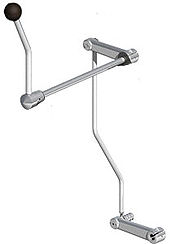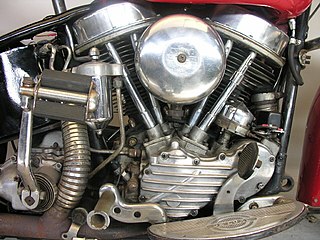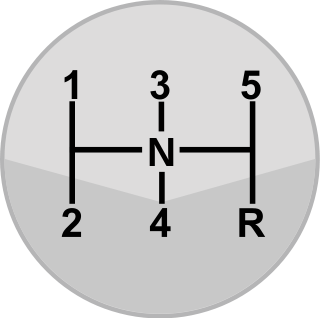This article has multiple issues. Please help improve it or discuss these issues on the talk page . (Learn how and when to remove these template messages)
|


The terms suicide clutch, and suicide shifter or jockey shifter, refer to some motorcycles' foot-operated clutch and hand shifter to change gears. [1] [2] [3] [4] [5] [6] Foot clutches (rocker-clutches) and hand shifters (tank-shifts) were found on early motorcycle designs from around the turn of the 20th century to the 1940s or 50s, and reappearing on modern retro styled custom motorcycles and choppers. Modern motorcycles do not require removing a hand from the handlebars to shift gears, using only the fingers for the clutch and the toes of one foot to select gears. [7] In contrast, the fanciful slang "suicide" was applied to designs where the rider removes one hand to change gears, or cannot put both feet on the ground while using a foot clutch to disengage the transmission. Sometimes the shifter is referred to as a "jockey shifter" while the foot clutch is called a "suicide clutch".
Contents
Suicide clutches were common on mid-20th century Harley-Davidson motorcycles and many custom bikes today still employ this system. Harley-Davidson introduced the hand clutch on the 1952 Panhead. [8]
More technically, "suicide clutch" can refer to clutch controls lacking a detent on the foot clutch, which would otherwise allow the rider to lock the clutch in the disengaged position. Early foot-clutch motorcycles, such as those from Harley-Davidson and Indian, allowed the rider to lock the clutch foot pedal due to its over-center geometry plus a helper spring (aka "sissy spring"), so they could place both feet on the ground when stopped. These standard clutches are called a "rocker clutch". If this device was disabled, or a custom foot clutch was installed that had no detent, it was referred to as a "suicide clutch" because stopping the motorcycle in-gear required the rider to keep his foot on the pedal. Should he lose his balance and put the left foot down, the motorcycle could lurch forward into cross traffic. The suicide clutch, especially on a chopper with no front brake, also made stopping at a red light on a hill especially precarious.
The suicide clutch is sometimes incorrectly called a suicide shifter. The suicide clutch is a foot-operated clutch that is mounted on the left side of the motorcycle's forward foot controls. [9] The suicide-clutch moniker has derived from difficulties in operating this form of clutch and shifter. On a motorcycle equipped with a conventional hand clutch and foot shifter, the rider places the left foot on the ground when stopped and holds the motorcycle in place with pressure on the rear brake pedal with the right foot, while engaging the clutch with the left hand. On a motorcycle equipped with a suicide clutch, the clutch is held in with the left foot, requiring the right foot to hold the bike in place, with the right hand applying pressure to the front brake. Early Harley Davidson foot clutches used an over-center spring to hold the clutch pedal in the disengaged position and used a friction disc to allow the rider to adjust the sensitivity of the return. Often riders removed the spring to keep the clutch pedal from returning to the disengaged position while riding. While this spring removal allowed for the clutch to stay engaged better, it also removed the safety feature of the clutch pedal holding itself in the disengaged position. With the pedal not returning to its natural disengaged position, the rider must either shift into neutral or hold the clutch pedal with the left foot when coming to a stop. Early Harley Davidson racers removed the clutch return spring to ensure the clutch stayed in the engaged position throughout the race. This practice soon caught on with other riders. The term "suicide clutch" was coined by those who could not operate the foot clutch proficiently enough to ride a tank shift (or hand shift) motorcycle in normal traffic.



















